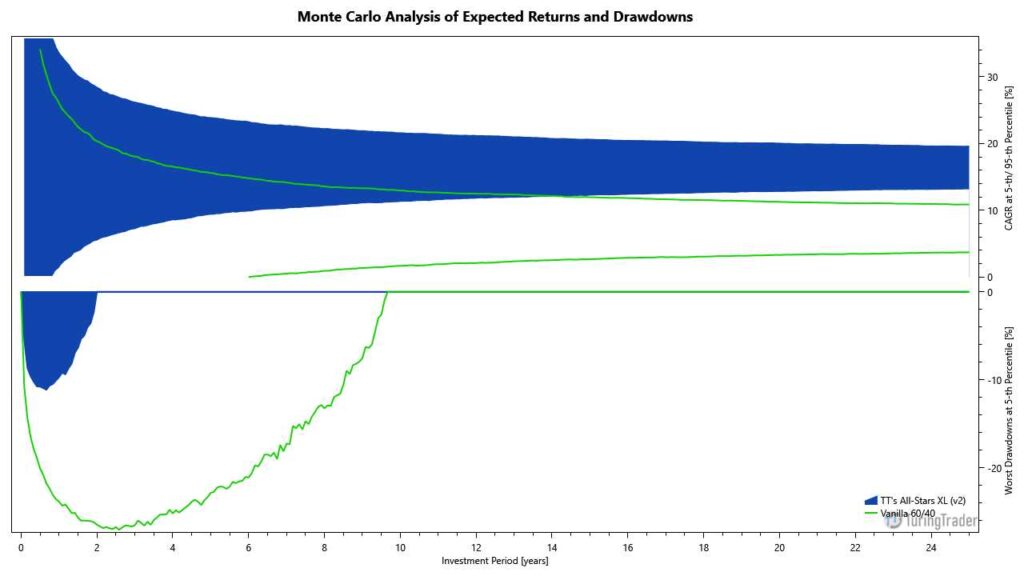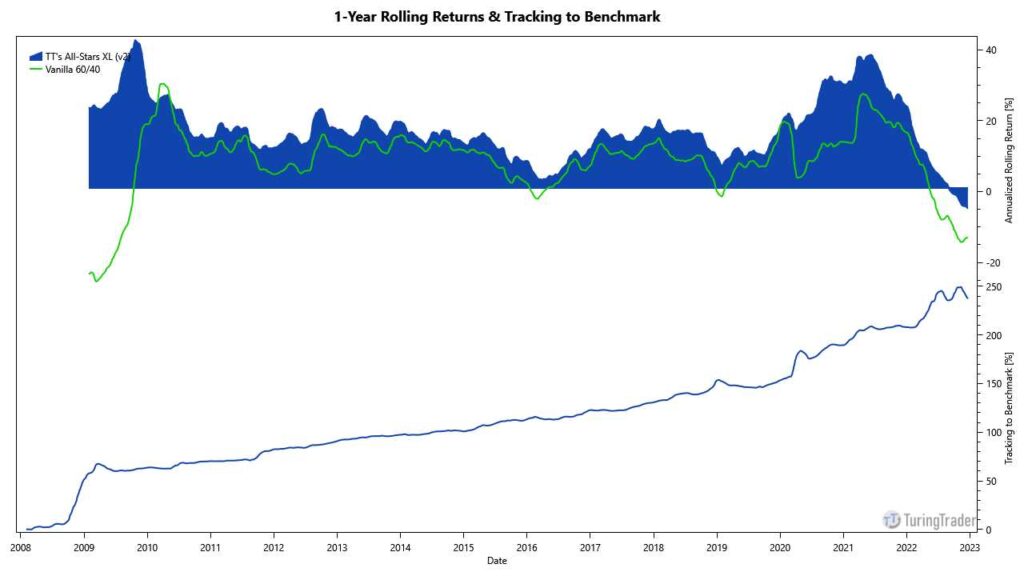Summary
- Objective: balanced growth
- Type: momentum strategy
- Invests in: individual stocks, bond ETFs
- Rebalancing schedule: Weekly
- Taxation: 90% short-term capital gains
- Minimum account size: $15,000
TuringTrader’s Stocks on a Stroll aims to provide returns on par with the balanced 60/40 benchmark but at considerably lower volatility. The strategy is a proprietary expansion upon Clenow’s Stocks on the Move, featuring a momentum approach combined with fixed-fraction position-sizing and a healthy position in managed bonds. With its weekly rebalancing schedule, the strategy has moderate maintenance requirements. In summary, Stocks on a Stroll appeals to risk-conscious investors seeking balanced growth.
Performance
This table shows the portfolio’s key performance metrics over the course of the simulation:
The following chart shows the portfolio’s historical performance and drawdowns, compared to their benchmark, throughout the simulation:
This chart shows the portfolio’s annual returns:
The following charts show the Monte-Carlo simulation of returns and drawdowns, the portfolios 12-months rolling returns, and how the portfolio is tracking to its benchmark:


Asset Allocation
The portfolio last required rebalancing after the exchanges closed on @last-rebal@. Due to fluctuations in asset prices, the exact allocations vary daily, even when no rebalancing occurred. The current asset allocation is as follows:
Sign up for our FREE Basic membership to see the asset allocation.
Sign up for our FREE 14-day trial to see the asset allocation.
Strategy Rules
The operation of Stocks on a Stroll can be summarized as follows:
- trade all S&P 100 stocks, plus U.S. treasuries as a risk-off asset
- rebalance once per week (on Wednesdays)
- disqualify stocks trading below their 100-day moving average
- disqualify stocks that made any single-day moves exceeding 10% in the past 90 days
- rank stocks by their volatility-adjusted momentum, calculated as the product of slope and R2 of a 90-day logarithmic regression
- only open new positions, if TuringTrader’s Market Vane indicates bullish conditions
- use fixed-fractional position sizing, based on the 20-day average trading range
- ensure healthy position sizes by limiting total portfolio risk, capping the maximum allocation to a single stock, and scaling back exposure with increasing market volatility
- invest any unused capital in TuringTrader’s Buoy portfolio
Most of these rules are taken verbatim from Clenow’s Stocks on the Move strategy. We recommend reading Clenow’s book to understand the strategy’s rationale better.
Expanding upon Clenow’s work, we improved the money management to remedy the following issues: concentration in too few assets, taking excessive total portfolio risk, and holding idle cash. Further, we added a significant position in our Buoy portfolio. These proprietary changes give the portfolio a docile personality: Instead of creating outsized returns, Stocks on a Stroll focuses on achieving a smooth equity curve with minimal volatility.
Diversification
Stocks on a Stroll typically allocates between 25% and 40% of its capital to 4 stocks and reduces this exposure in times of market stress. The portfolio invests the remaining capital in our Buoy portfolio.
With this allocation, the portfolio offers some intrinsic protection against market crashes, which is further augmented through its active management. As a result, Stocks on a Stroll has a remarkably low beta of less than 0.25.
Returns & Volatility
Stocks on a Stroll offers a significantly lower risk profile than a passive 60/40 portfolio. At the same time, the strategy beats its benchmark in many years. Over the entire economic cycle, Stocks on a Stroll beats the S&P 500, even though it is lagging the index most years. This is possible because the portfolio avoids steep losses in times of market turbulence.
The Monte-Carlo simulation shows Stocks on a Stroll‘s admirably flat risk and return profiles. The portfolio has a solid upside over the benchmark, but only about 40% of the risk. We typically see similar risk profiles only in bond-heavy cross-asset portfolios, e.g., Robbins’ All-Seasons Portfolio, and at the expense of absolute returns.
Account & Tax Considerations
Stocks on a Stroll trades frequently and will trigger taxable events regularly. Investors should expect that shares are seldom held long enough to qualify for long-term capital gains. Consequently, the strategy will work best in tax-deferred accounts.
Because the strategy holds up to 4 high-flying and potentially expensive stocks simultaneously, it requires no less than $15,000 to function as intended.
